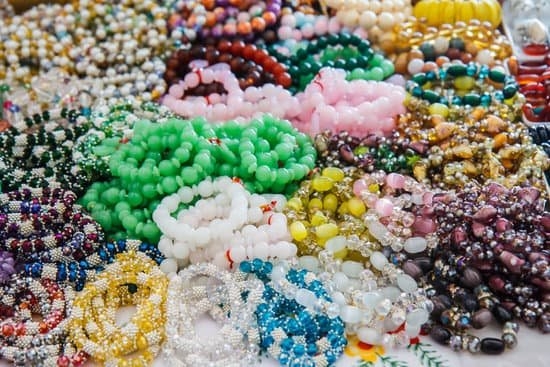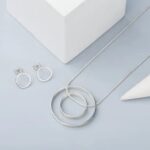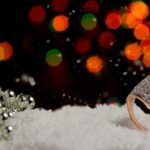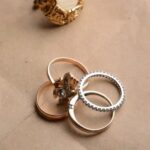When shopping for diamond jewelry, it is important to be able to distinguish between real diamonds and imitations. The last thing you want is to spend your hard-earned money on a piece of jewelry that turns out to be fake.
That’s why it’s crucial to know how to accurately determine if the jewelry you are considering is made with real diamonds. In this article, we will guide you through the process of discerning genuine diamond jewelry from imitations.
Diamonds are one of the most sought-after gemstones in the world, known for their brilliance and rarity. However, they also come with a hefty price tag, making it even more critical to know how to recognize authenticity. By understanding what to look for when buying diamond jewelry, you can make an informed decision and ensure that your investment is true value for money.
In this article, we will explore various methods and techniques that can help you determine if the jewelry is made with real diamonds or not. We will discuss the basics of diamond grading, including the famous 4 Cs – cut, color, clarity, and carat weight.
Additionally, we will dive into physical characteristics like brilliance and fire that authenticate a diamond’s beauty. Furthermore, we will delve into the importance of certification from trustworthy gemological laboratories and highlight some popular tests used by experts in the industry.
Stay tuned as we unravel the secrets behind authenticating diamond jewelry and debunk common myths surrounding fake diamonds. With our handy tips and tricks, you’ll have all the knowledge you need to confidently shop for real diamond jewelry without falling victim to scams or replicas.
The 4 Cs
When it comes to buying diamond jewelry, it is essential to have a good understanding of the basics of diamond grading. This knowledge will help you make an informed decision and ensure that you are getting a real diamond. The 4 Cs, which stand for cut, color, clarity, and carat weight, are the universally recognized characteristics used to evaluate and grade diamonds.
Firstly, let’s talk about the cut. The cut refers to how well a diamond has been shaped and faceted by a skilled craftsman. It affects the brilliance and sparkle of the stone.
A well-cut diamond will reflect light internally from one facet to another before exiting through the crown of the diamond, creating a stunning display of brilliance. On the other hand, a poorly cut diamond may leak light through its sides instead of reflecting it back up, resulting in reduced sparkle.
Next is color. Although diamonds may appear colorless at first glance, they can actually possess subtle hints of yellow or brown. The Gemological Institute of America (GIA) has developed a color grading scale that ranges from D (colorless) to Z (light yellow or brown). A higher grade indicates less visible color and thus higher value.
Clarity refers to the presence or absence of internal flaws called inclusions and external blemishes on a diamond. These imperfections can affect the overall beauty and transparency of the stone. The GIA grades clarity on a scale ranging from Flawless (no inclusions or blemishes visible under 10x magnification) to Included (inclusions visible with the naked eye).
Lastly, carat weight measures how much a diamond weighs. It is important to note that carat weight does not determine a diamond’s size but rather its mass. A small difference in carat weight can significantly impact its value if all other factors remain constant.
Understanding these 4 Cs will help you assess the quality and value of diamond jewelry before making a purchase. Remember, the combination of these characteristics contributes to the overall beauty, rarity, and price of a diamond. So take the time to educate yourself about the 4 Cs and consult with a reputable jeweler to ensure that you are getting a real diamond that meets your standards and budget.
Section
When it comes to assessing the authenticity of diamond jewelry, one of the key factors to consider is the physical appearance of the diamond. This includes assessing its brilliance and fire, which are characteristics that truly stand out in a genuine diamond.
Brilliance refers to the amount of light that enters a diamond and reflects back to the viewer’s eye. A real diamond will naturally have a high level of brilliance due to its ability to reflect and refract light. When examining a diamond, look for an intense sparkle and brightness.
Hold the diamond up to various light sources and observe how it scatters light. If you notice that the stone is dull or lacks vibrancy, it may be an indication that it is not a real diamond.
Fire is another important aspect to consider when evaluating the genuineness of diamond jewelry. Fire refers to the way in which a genuine diamond disperses white light into a spectrum of colors. This creates an eye-catching play of colors within the stone, often resembling flashes or sparkles.
Hold the diamond under different lighting conditions and observe if you can see flashes of color or rainbow-like patterns within the stone. If there is no visible dispersion of colors, it may suggest that the stone is not a real diamond.
In addition to brilliance and fire, other aspects related to physical appearance can also help determine whether jewelry contains real diamonds or not. For instance, examine how well-cut and well-proportioned the stone appears. Genuine diamonds are typically cut with precision by expert craftsmen, resulting in beautiful symmetry and balance.
Look for evenness in terms of how light passes through different facets of the stone. If there are noticeable asymmetries or inconsistencies in its appearance, it could be an indication that the gemstone is not authentic.
By carefully assessing these physical characteristics – including brilliance, fire, cut quality, symmetry, and proportion – buyers can gain valuable insights into whether a piece of jewelry contains real diamonds or not. It is important to note that these observations should not be the only determining factors, as there are other tests and considerations needed to ensure full authenticity. However, a thorough examination of the physical appearance is definitely a good starting point in identifying real diamond jewelry.
Section
As a consumer, it is important to have confidence when purchasing diamond jewelry. One way to ensure the authenticity and quality of a diamond is through certification from trustworthy gemological laboratories. These laboratories are responsible for assessing and grading diamonds based on their unique characteristics.
Gemological laboratories conduct thorough examinations of diamonds using advanced equipment and expert gemologists. They evaluate the 4 Cs: carat weight, color, clarity, and cut, which determine the value of a diamond. By obtaining a certification from a reputable lab, consumers can be assured that they are purchasing a genuine and accurately graded diamond.
One well-known and respected gemological laboratory is the Gemological Institute of America (GIA). Established in 1931, the GIA has built an excellent reputation in the diamond industry for its rigorous grading standards and unbiased assessments. Their certifications provide detailed information about a diamond’s quality and characteristics, giving consumers the confidence they need when making a purchase.
Another widely recognized gemological laboratory is the International Gemological Institute (IGI). With locations worldwide, IGI provides independent evaluations of diamonds based on international grading standards. Their certifications also include detailed descriptions of a diamond’s unique features.
To further ensure authenticity, it is important to look for certifications from these or other reputable gemological laboratories when purchasing diamond jewelry. This not only provides confirmation that the diamond is genuine but also guarantees its quality and value.
Testing the Hardness – The Scratch Test
When it comes to determining the authenticity of a diamond, one important test that can be conducted is the scratch test. This test involves using another diamond or a material with a known hardness, such as corundum, to scratch the surface of the suspected diamond. Genuine diamonds are known for their exceptional hardness and should not be easily scratched by other materials.
To conduct the scratch test, start by obtaining a small piece of corundum or another diamond with a known hardness. Gently but firmly rub this material against the surface of the jewelry in question. If no scratches or marks are left behind on the jewelry, it is likely that you have authentic diamond jewelry. However, if visible scratches are present on the surface, it may indicate that the jewelry is made from lesser quality materials.
It is important to note that while a lack of scratches indicates authenticity, the presence of scratches does not necessarily mean that the jewelry is fake. Some materials used in counterfeit diamonds can still withstand this test due to coatings or other treatments applied to increase their hardness. Therefore, it is recommended to use this test in combination with others to ensure accurate results when assessing diamond authenticity.
In addition to conducting individual tests such as the scratch test, it is also advisable to seek professional help from gemological experts who possess specialized equipment for identifying authentic diamonds. They can provide more comprehensive analysis and certification that guarantee accuracy in determining whether the jewelry is real diamond or an imitation. Remember, genuine diamonds are not easily scratched by common materials and seeking expert advice can help confirm your suspicions regarding the authenticity of your precious piece of jewelry.
Testing the Conductivity – The Fog Test
One of the methods to determine whether or not a diamond is real is by conducting the fog test. This simple test can be done at home and does not require any special equipment. The principle behind the fog test is that diamonds are excellent heat conductors, so they disperse heat quickly.
To perform the fog test, hold the diamond or piece of jewelry you want to test between your fingers and breathe on it as if you were trying to fog up glass. If the diamond fogs up, it indicates that it is not a real diamond since diamonds do not retain heat well enough to create condensation. Real diamonds will remain clear even when breathed upon.
It is important to note that while the fog test is a quick and easy way to check for authenticity, it should not be solely relied upon. Some imitations may also pass this test, so it is always wise to combine multiple tests and consider other factors before making a conclusion.
To further validate the results of the fog test, try pairing it with other tests like the scratch test or water test, which assess different properties of diamonds. By using multiple testing methods, you can have a more reliable evaluation of whether your jewelry contains genuine diamonds or not.
In summary, the conductivity-fog test is an efficient way to verify if a diamond is authentic without any specialized equipment necessary. However, it should be used in conjunction with other tests and considerations before concluding whether or not your jewelry contains real diamonds.
Testing Refraction – The Water Test
When it comes to testing the authenticity of a diamond, one important factor to consider is its refraction. Refraction refers to the way light bends as it passes through a diamond. Real diamonds have a unique ability to refract light, creating an impressive and eye-catching sparkle. To determine if your jewelry contains a real diamond, you can perform the water test.
How to Perform the Water Test
The water test is a simple yet effective way to assess a diamond’s refraction. To conduct this test, you will need a clean glass and a source of natural light. Start by filling the glass with room temperature water and placing it on a flat surface near the source of light.
Next, carefully drop your diamond jewelry into the glass, making sure it is completely submerged. As you observe the gemstone through the water, take note of how it interacts with light. A genuine diamond will refract light in such a way that creates prismatic colors like rainbow reflections. If you notice vibrant flashes of color or intense sparkle, then chances are high that your jewelry contains real diamonds.
On the other hand, if the gemstone appears dull or does not exhibit any colorful reflections, it may be an indication that the stone is not a real diamond. However, keep in mind that this test alone cannot provide definitive proof of authenticity but can serve as an initial indicator.
Additional Considerations
While conducting the water test can give you some insight into whether your jewelry contains real diamonds or not, it is important to note that there are other factors that can affect the results. For instance, certain treatments or enhancements applied to diamonds may alter their refraction properties.
Additionally, different types of gemstones may also produce colorful reflections when submerged in water due to their own unique physical properties. Therefore, if you are unsure about the authenticity of your diamond jewelry after performing this test, it is recommended to seek professional advice from a gemologist or a reputable jeweler who can provide further analysis and testing.
The Price Factor
When it comes to determining the authenticity of diamond jewelry, the price factor can be a helpful indicator. Comparing market prices and identifying deals can give you valuable insights into whether the jewelry in question is made with real diamonds. Here are some factors to consider when evaluating the price of diamond jewelry:
Market Standards
One way to assess the authenticity of diamond jewelry is by being aware of current market standards. Familiarize yourself with the average prices for diamonds of various carat weights, colors, clarities, and cuts. If you come across a piece of jewelry that is priced significantly lower than these average market prices, it may be a red flag.
Discounts and Deals
While it’s important to be cautious about exceptionally low prices, there are instances where legitimate discounts and deals can be found. Keep an eye out for special promotions from reputable jewelers or authorized dealers. These discounts may apply during certain times of the year or for specific designs or collections. However, exercise caution if a deal seems too good to be true, as it might indicate that the diamonds used are not genuine.
Secondary Market
Another avenue to explore when comparing market prices is the secondary market. This includes pre-owned or vintage diamond jewelry. In certain cases, you might find authentic diamond pieces at relatively lower prices compared to buying new items from retail stores. However, it’s essential to conduct thorough research and work with reputable sellers who can provide appropriate documentation and certifications for their products.
By considering these factors when assessing the price of diamond jewelry, you can gain confidence in identifying authentic pieces and potential deals in the market. Remember that consulting with a trusted gemologist or jeweler can provide further guidance in determining if the price aligns with the quality and authenticity of the diamonds used in the piece you’re interested in purchasing.
Caveats and Considerations
When determining the authenticity of a diamond, there are certain caveats and considerations that one must keep in mind. These factors can greatly influence the credibility of the diamond and provide valuable insight into its quality and value.
One important consideration is the source or origin of the diamond. Conflict diamonds, also known as blood diamonds, are stones that are mined in war zones and sold to finance armed conflict against governments.
It is crucial to ensure that the diamond you are purchasing has been ethically sourced and does not contribute to any human rights violations or environmental harm. Look for diamonds that come with certification from organizations such as the Kimberley Process Certification Scheme, which guarantees that the diamonds are conflict-free.
Another factor to consider when assessing diamond authenticity is the presence of treatments or enhancements. Diamonds may undergo treatments to enhance their color, clarity, or overall appearance. While these treatments can improve a diamond’s visual appeal, they can also impact its value.
Common treatments include laser drilling to remove visible inclusions or fracture filling to conceal surface-reaching fractures. It is important to be aware of these treatments when purchasing a diamond so that you can make an informed decision.
Furthermore, it is essential to consider the setting in which a diamond is presented. Some jewelers may use nickel alloys instead of precious metals such as gold or platinum for the setting, which can cause allergic reactions in individuals with nickel sensitivities.
Additionally, certain settings may not securely hold the diamond in place, putting it at risk of becoming loose or falling out entirely. Always examine the craftsmanship of the setting and opt for reputable jewelers who prioritize quality materials and construction.
In summary, understanding these caveats and considerations can greatly assist in verifying the authenticity of a diamond. By considering factors such as ethical sourcing, possible treatments or enhancements, and the quality of the setting, individuals can make more informed decisions when purchasing jewelry containing diamonds.
| Factor | Consideration |
|---|---|
| Diamond Source | Ensure the diamond is ethically sourced and conflict-free. |
| Treatments and Enhancements | Beware of any treatments or enhancements that may impact the diamond’s value. |
| Setting Material and Craftsmanship | Examine the quality of the setting to ensure durability and avoid allergic reactions. |
Conclusion
In conclusion, there are several clever tips that can help you differentiate authentic diamond jewelry from fakes. By understanding the basics of diamond grading, such as the 4 Cs – cut, color, clarity, and carat weight – you can assess the physical appearance of a diamond and determine its authenticity. Additionally, relying on trustworthy gemological laboratories and certifications can provide further assurance of a diamond’s authenticity.
Testing the hardness of a diamond through the scratch test is another reliable method for differentiating between real and fake diamonds. Genuine diamonds are one of the hardest substances on Earth and should not easily scratch against other materials.
Another useful test is the fog test, which involves breathing onto the surface of a diamond to check if it quickly fogs up. Real diamonds disperse heat rapidly and will not retain any fog for more than a couple of seconds. However, fake diamonds may take longer to clear or retain fog altogether.
The water test is also an effective way to assess refraction in a diamond. By placing a loose diamond into a glass of water, you can observe how light bends as it passes through the stone. A genuine diamond will refract light in such a way that you cannot clearly see through it when submerged in water.
Lastly, it’s important to compare market prices and identify deals when purchasing diamond jewelry. If an offer seems too good to be true, it probably is. Authentic diamonds come with a high price tag due to their rarity and value. Conduct research on average prices and sellers before making any purchases.
Frequently Asked Questions
How can I tell if my diamond is real?
To determine if your diamond is real, there are a few methods you can use. One of the most effective ways is by conducting a visual inspection. Real diamonds typically refract light in a noticeable way, creating a sparkle known as the “brilliance” of a diamond. Another method is to check for imperfections or inclusions within the diamond.
Natural diamonds often have slight flaws that can be seen under magnification. You can also use the scratch test by trying to scratch a piece of glass with the diamond. Since diamonds are one of the hardest substances on Earth, they should not get scratched by glass.
Can a jeweler tell if a diamond is real?
Yes, professional jewelers have the expertise and tools to determine if a diamond is real or not. They often use gemological equipment like microscopes, loupes (magnifying glasses), and thermal conductivity testers to examine diamonds and confirm their authenticity.
Jewelers are trained to evaluate various aspects including clarity, color, cut, and carat weight to assess whether a diamond is genuine or an imitation.
Is there an app to test diamonds?
Yes, there are mobile apps available that claim to assist in testing diamonds; however, their accuracy may vary and should be taken with caution. These apps usually work by utilizing your smartphone camera and analyzing certain characteristics such as patterns or light refraction to estimate whether a diamond is real or simulated.
It’s important to note that relying solely on an app may not provide definitive results like those obtained by professional gemologists or jewelers using proper equipment. Therefore, while such apps might give you an initial indication, it’s advisable to consult an expert for accurate verification if you’re uncertain about the authenticity of your diamond.

Welcome to my jewelry blog! My name is Sarah and I am the owner of this blog.
I love making jewelry and sharing my creations with others.
So whether you’re someone who loves wearing jewelry yourself or simply enjoys learning about it, be sure to check out my blog for insightful posts on everything related to this exciting topic!





